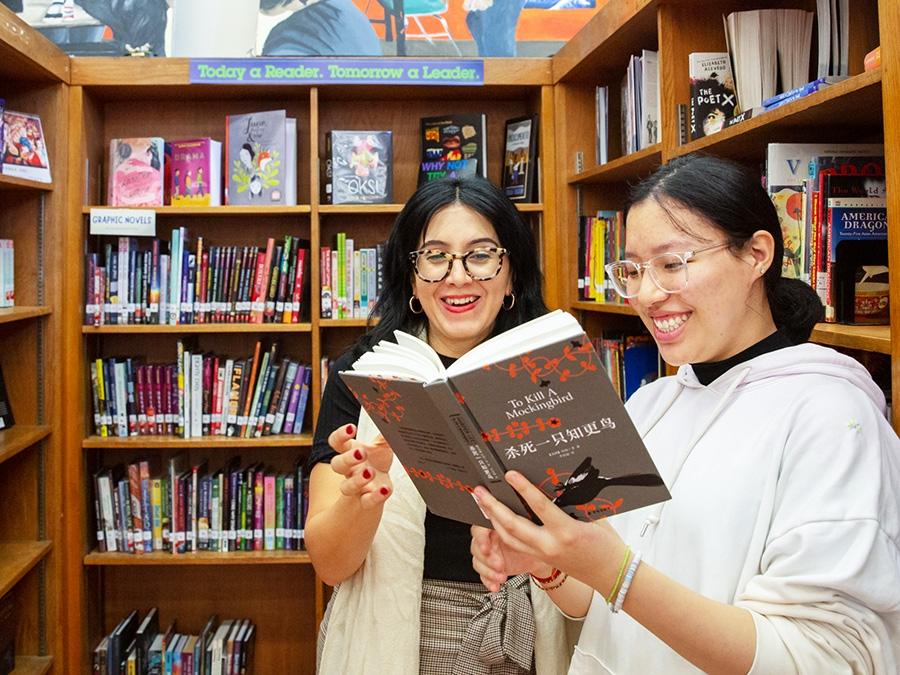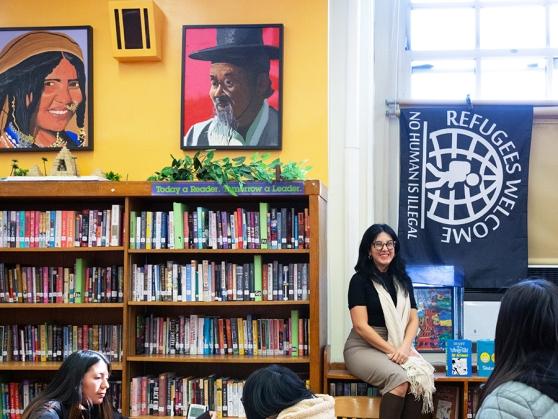
ENL teacher and librarian Zalykha Mokim (left) surveys a Chinese version of “To Kill a Mockingbird” at Newcomers HS in Queens with student library intern Sonam Dolkar, whose family came to the United States from Tibet.

Mokim works hard to make the library a welcoming space for multilingual learners. Student-painted artwork of indigenous people decorates the walls.
“I was very sad going to school and being not able to communicate,” Luincys Fernandez said about her first days in a New York City public school as a 12-year-old after emigrating from the Dominican Republic. “For a time, I became mute. I just listened and listened and I couldn’t figure it out, not even a word of what they were saying. I felt like I was getting smaller and smaller and the world was getting bigger and bigger.”
Fernandez, then 17, described her experience on a PBS show from 1999. But she articulates an isolation that tens of thousands of New York City public school students who are altogether new to the country — including nearly 6,000 children from asylum-seeking families from Latin America this fall — could easily feel without the support of culturally attuned and linguistically diverse educators to meet their unique learning and social-emotional needs.
“Our students’ families have made massive sacrifices for them to be here, and we as educators have to support them,” said Zalykha Mokim, an English as a New Language teacher and the librarian at Newcomers HS in Long Island City, Queens.
More than half — about 75,000 — of the approximately 140,000 English language learners in New York City public schools are designated as “newcomers,” which the city Department of Education defines as any student who has lived in the country for fewer than three years. Some of them are living far apart from their families for the first time; some have experienced trauma. All of them are adapting to a huge life change.
At schools like Newcomers HS, the presence of other multilingual students and educators helps new students feel at home. More and more research supports the once-controversial idea that embracing multilingual students’ home language reinforces their progress in English rather than threatening it.
Mokim stocks the Newcomers HS library with books in a variety of languages — Spanish, French, Chinese, Gujarati, Bangla — and has built a robust collection of graphic novels and manga, a style of Japanese comic books, to make written English more accessible to multilingual students. Learning English is at the forefront, she said, “but as culturally responsive educators, we all know that strengthening a student’s home language supports their development in a second language, and it’s also incredibly valuable from a social-emotional point of view.”
Incorporating the home language is a particularly useful strategy with Spanish, which uses the same written alphabet as English and shares many cognates with the language (like family and familia, or adventure and aventura). Colorín Colorado, a national resource for educators and families of English language learners, points out that almost 40% of English words have a related word in Spanish.
“For kids who are reading and writing on grade level in Spanish, I focus on showing them how letter sounds are different in English and Spanish, mostly the vowels, and once they have that, it’s really a matter of teaching them vocabulary,” said Ben Ehrlich, who teaches an English/Spanish dual language class at PS 92 in Corona, Queens. “But if they don’t have a foundation in Spanish, it’s hard to start teaching them in English. You have to build up the foundation in their native language.”
Young children are often excited to start school even when they don’t know the language. But older newcomers — like Luincys Fernandez — can find it more challenging to adjust. Although anyone without a high school diploma or equivalent is eligible to attend school until age 21, almost 18% of newcomers ages 14 to 21 nationwide were not enrolled in school between 2015 and 2019, according to a Migration Policy Institute analysis. Some may have found it too difficult to juggle school and work; others may have been intimidated to take courses in a language they didn’t know.
In the spring of 2022, the city Department of Education announced a pilot program to expand to 11 the number of transfer high schools that support newcomers. Transfer high schools serve students ages 16-21 who need to catch up on credits to graduate. Before this school year, only five of the city’s 50-plus transfer high schools specifically served English language learners, and four of those schools were located in Manhattan — even though the majority of newcomer high school students live in the Bronx.
Lower East Side Preparatory HS is one of those transfer high schools. Teachers certified in teaching English to speakers of other languages (TESOL) offer bilingual classes in both Spanish and Mandarin. Students receive English as a New Language instruction twice a day while also receiving content-area instruction in their home language.
“They’re getting as much English instruction as they can while also taking content in their own language as they build their English skills,” said Chapter Leader Eric Grossmann.
The Education Collaborative, which is made up of 30 community organizations, has pushed the DOE to dedicate funds to these schools for English as a New Language teachers, bilingual social workers, wraparound support from community organizations, professional learning for educators and student internships.
That kind of intensive support in city schools can make a difference for newcomers who may feel traumatized or overwhelmed.
“We have a community here where it’s safe to be an immigrant, where it’s safe to be undocumented, where it’s safe to not speak English,” said Mokim. “We welcome them with open arms.”